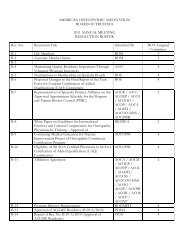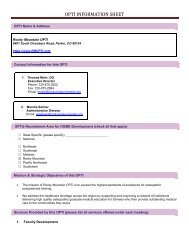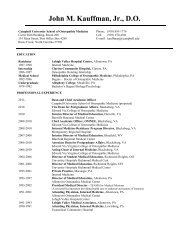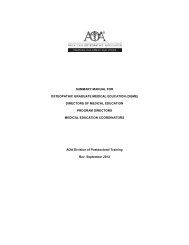Dialogue and Diagnosis - American Osteopathic Association
Dialogue and Diagnosis - American Osteopathic Association
Dialogue and Diagnosis - American Osteopathic Association
Create successful ePaper yourself
Turn your PDF publications into a flip-book with our unique Google optimized e-Paper software.
Basal insulin alone<br />
Sequential addition of<br />
pr<strong>and</strong>ial insulin before<br />
meals with high PPG levels<br />
Basal Bolus insulin<br />
(multiple daily injections<br />
Consider gold st<strong>and</strong>ard;<br />
allows customization<br />
to food activity<br />
Simple way to start<br />
increasing number<br />
of injections<br />
Often with oral agents<br />
continued<br />
Premixed insulin<br />
three times a day<br />
Premixed insulin<br />
twice a day<br />
Premixed insulin<br />
once a day<br />
Provides basal<br />
<strong>and</strong> pr<strong>and</strong>ial insulin<br />
in a single injection<br />
Figure 2. Sequential insulin strategies<br />
for patients with type 2 diabetes<br />
mellitus.<br />
Adapted with permission from Inzucchi SE,<br />
Bergenstal RM, Buse JB, et al; <strong>American</strong><br />
Diabetes <strong>Association</strong> (ADA); European<br />
<strong>Association</strong> for the Study of Diabetes (EASD).<br />
Management of hyperglycemia in type 2<br />
diabetes: a patient-centered approach: position<br />
statement of the <strong>American</strong> Diabetes <strong>Association</strong><br />
(ADA) <strong>and</strong> the European <strong>Association</strong> for the<br />
Study of Diabetes (EASD). Diabetes Care.<br />
2012;35(6):1364-1379.<br />
Figure 2 <strong>and</strong> Table 2, provides considerations<br />
regarding which type of<br />
pr<strong>and</strong>ial coverage may be most suitable<br />
for a given patient. While basalbolus<br />
insulin therapy required more<br />
injections, it tends to increase day-today<br />
life flexibility.<br />
Given Sam’s erratic schedule, premixed<br />
insulin is not a desirable treatment<br />
option for him. Because he will<br />
likely need to titrate pr<strong>and</strong>ial insulin<br />
doses according to meal times <strong>and</strong><br />
sizes, the addition of a pr<strong>and</strong>ial<br />
insulin at the largest meal is the most<br />
attractive option. Data from the Orals<br />
Plus Apidra <strong>and</strong> LANTUS (OPAL)<br />
trial 33 showed that a single bolus of<br />
pr<strong>and</strong>ial insulin analog improved<br />
HbA 1c levels when added to a basal<br />
insulin analog <strong>and</strong> oral antidiabetic<br />
agents (Figure 3).<br />
Challenges in adding<br />
medications to<br />
therapeutic regimens<br />
Recent data suggest that most<br />
patients with diabetes mellitus have<br />
negative perceptions of the initiation<br />
of additional medications, viewing it<br />
as evidence of personal failure <strong>and</strong><br />
increased burden. 34 Patients equate<br />
medication intensification with<br />
Requires some<br />
consistency in food<br />
intake/exercise<br />
increased risk for diabetes-related<br />
complications rather than a step in<br />
reducing risk. They view de-escala -<br />
tion of medication as their primary<br />
goal. However, patients respond<br />
favorably to an individualized medication<br />
plan outlining future contingencies.<br />
34 According to the international<br />
Diabetes Attitudes, Wishes,<br />
<strong>and</strong> Needs (DAWN) study, 35 more<br />
than half (57%) of all patients with<br />
T2DM are very worried about starting<br />
insulin therapy.<br />
Many factors contribute to this<br />
worry. As previously noted, feelings<br />
of failure or depression (regarding following<br />
lifestyle changes <strong>and</strong><br />
adherence to therapy), as well as the<br />
sense that using insulin means that<br />
their diabetes has worsened, may lead<br />
to resistance to insulin therapy. Many<br />
patients who are resistant to insulin<br />
therapy may also be reluctant to<br />
accept the responsibilities of everyday<br />
management of insulin therapy. 36<br />
Insulin should be offered to patients<br />
in a positive light—as a means to<br />
improve their health. Reminding<br />
them early in the disease that there<br />
may be times insulin is needed in a<br />
pinch, such as a critical illness or hospitalization,<br />
may help. This approach<br />
might facilitate their acceptance of<br />
insulin therapy. Physicians can help<br />
patients at the time of diagnosis by<br />
explaining that diabetes mellitus is a<br />
progressive disease, <strong>and</strong> that changes<br />
in therapy over the course of a<br />
lifetime in no way reflect badly on<br />
the patient.<br />
Premixed Insulin<br />
Basal-Bolus Insulin<br />
(1, 2, or 3 injections of same insulin) (4 injections; 2 types of insulin)<br />
— Preference for few injections — Variable meal pattern<br />
— Fixed daily routine — Variable daily routine<br />
— Unwilling to monitor blood glucose* — Postpr<strong>and</strong>ial control an issue<br />
— Limited cognitive function* — Able to comply with complicated<br />
— Limited healthcare support system* regimen (eg, willing <strong>and</strong> good<br />
*the last 3 apply when relaxed glucose<br />
cognitive function)<br />
targets are applied<br />
— Support system available<br />
Table 2. Criteria for choosing between premixed vs basal-bolus insulin.<br />
<strong>Dialogue</strong> <strong>and</strong> <strong>Diagnosis</strong> // September 2012<br />
7

















